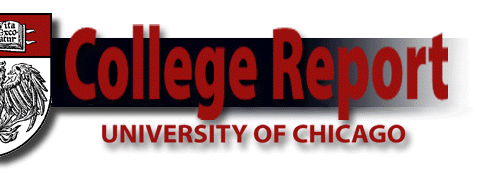|

Curricular
revisions draw national media attention
Changes in
the College made news beyond campus as the new year began, starting
with a front-page story in the New York Times and followed
by articles and columns in the Wall Street Journal, the Chicago
Tribune, and the Chicago Sun-Times.
The roots
of the media flurry can be traced to March of last year, when the
faculty College Council voted to revise the undergraduate curriculum
adopted in 1984. With three of 21 required core courses shifted
to electives, the total number of required courses remains 42. Going
into effect in fall 1999, the revised core—still the most extensive
set of core requirements in the country—comprises 6 quarters
of science and mathematics, as opposed to 8; 6 quarters of humanities,
civilization, and fine arts, instead of 7; 3 quarters of social
science (no change); and tested competency in a foreign language
rather than 3 quarters of college-level course work. The revisions
are designed to give students more opportunities for advanced study
and research with faculty, the option of a double major, and greater
access to the College’s new intensive foreign-language and
civilizations courses.
The December
28 Times featured a page-one analysis of the “winds
of academic change” rustling the U of C. Besides the revised
core requirements, the changes cited were an expansion of campus
recreation and service offerings, including the construction of
the Gerald Ratner Athletics Center, to be completed in 2001. Also
noted were plans to increase the undergraduate enrollment from the
current 3,850 students to 4,500 by 2006, approaching levels last
seen in the 1930s.
Times
education reporter Ethan Bronner recited the forces behind these
shifts: too few applicants; too few alumni children applying; a
relatively high dropout rate; and an infrastructure in need of modernization.
Bronner compared Chicago’s 60 percent acceptance rate to Harvard’s
13 percent; Chicago’s 5 percent application rate among children
of alumni to the Ivy League’s 10 to 20 percent; and Chicago’s
83 percent graduation rate for entering first-years to the Ivy League’s
90-plus percent.
The article
concluded that Chicago is “in a painful identity crisis”
that “is being closely watched by educators across the country.”
President Hugo Sonnenschein agreed that Chicago is a higher-ed cynosure,
telling the Times that “Chicago has a special role and
responsibility because it has a reputation as embodying what a great
university should be.”
At the same
time, he continued, “The commodification and marketing of higher
education are unmistakable today and we can’t jolly dance along
and not pay attention to them. One hears constantly from parents
and students: ‘We are the consumer. We pay the tuition.’”
On January
8, the Journal’s “Weekend Journal” ran an
opinion piece by Bret Louis Stephens, AB’95. Reacting to the
Times article, Stephens, the Journal’s assistant editorial
features editor, worried that Chicago may be “tacking against
its own traditions and bending to the breeze of higher education
in the U.S.” He warned that “if the University of Chicago
is eventually to hollow out its core, we will all be a bit more
arrogant, and a great deal more ignorant.”
Both pieces
generated letters. Writing to the Times, Brown University
professor James A. Morone provided an ironic perspective: “[T]he
culture of choice championed by [Milton] Friedman [AM’33] and
[Gary] Becker [AM’53, PhD’55] now vexes the university
they loved.” Other writers, like Doreen Blanc Rockstrom, AB’64,
MAT’69, expressed concern that the effort to attract more students
would cheapen the College experience: “Watering down or substituting
job-oriented courses will not teach the most important lesson: preparation
for lifelong learning.”
The importance
of the University’s emphasis on lifelong learning and general
education also figured in letters to the Journal. In one,
Provost Geoffrey R. Stone, JD’71, disputed Stephens’ belief
that the University’s excellence “is in any way embodied
in the specific requirements of any particular version of the University’s
always-evolving and always-demanding undergraduate curriculum or
in the fact that it has not constructed an athletics facility for
more than six decades.”
The College
story received hometown coverage on January 31, in both the Tribune
(“At U. of C., C Stands for Chuckles”) and the Sun-Times
(“U. of C. Keeps Image in Mind”). Describing the University’s
efforts to ensure that applicants know that the College’s academic
offerings are balanced by other kinds of opportunity, both stories
noted some on- and off-campus fears that becoming known as a “fun
school” might dilute the University’s academic rigor.
Dean of the
College John W. Boyer, AM’69, PhD’75, took a long view,
telling the Sun-Times, “Like our students, the College
is dynamic. It comes out of a tradition, and it has to be responsive
to tradition. But tradition will die if it doesn’t change.”
For more on those changes, stay tuned to the Magazine.—M.R.Y.
|

